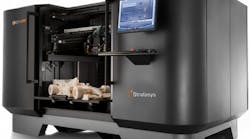No matter what engineers are designing, whether it is a spaceship or paper clip, they are all trying to make those products faster, better, and cheaper. Anyone who tries to accomplish all three of these simple goals soon realizes the challenge of meeting these criteria. With the phenomenal growth in the 3D printing industry over the past 10 years, achieving these goals is now a very real possibility. Here’s some comments on 3D printing and what it can do from Chris Richter, an applications and support engineer with R&D Technologies. He specializes in PolyJet and fused deposition modeling (FDM).
Confirming the design intent has been met and identifying potential issues are two important solutions provided by 3D printing, especially when it can be done in-house. With computer aided design software (CAD), designers can test designs to some degree, right within the software. However, as good as the simulations within the software have become, there comes a point when it’s quicker and easier to build a version of the final product to get user feedback on the design. Making functional or merely cosmetic prototypes is one tool for eliciting such feedback. Unfortunately, requests for 3D printed prototypes can often require in-house order approvals followed by lead times of several days before a 3D printed part arrives. Creativity can be stifled by having to wait for prototypes before moving forward with the design.
That’s where in-house 3D printers can keep the process moving and the creativity flowing by letting more design prototypes be built, tested, and criticized in shorter timeframes. It lets designers prototype earlier and more often in the design cycle and identify key changes that need to be made.
What benefits does 3D printing bring to the companies that design, manufacture, and sell products?
3D printed parts are useful in communicating the design intent to marketing and sales departments, as well as manufacturers and suppliers. After seeing and handling the 3D printed version of the product, marketing and sales will be better prepared to support it when it is released. Sharing the printed model with manufacturing and supply chains will help determine if the product can be economically manufactured and identify potential issues that may arise during manufacturing. Giving your manufacturers and suppliers an accurate representation of the end product could help prevent any miscommunication that could arise when interpreting the CAD models.
Can 3D printed products be field tested?
Yes, 3D printed objects that replicate the final products can certainly be field tested. This is due, in part, to the fact that material choices for 3D printing have expanded in recent years and now include urethane rubbers, water-clear acrylics, and full color palettes. In some cases, it is possible to 3D print with actual end-use material such as ABS, polycarbonate, and nylon, to name a few. In other cases, 3D printing can create injection molds, blow molds, and patterns for silicone molding. This lets prototypes be made in materials not yet available for 3D printing. Field testing a prototype identical to manufactured parts will provide valuable design and manufacturing data and could prevent costly mistakes and rework later.
Will customers benefit from 3D printing?
Customers should get the best possible product for their money, courtesy of the additional design iterations and testing the product will go through. 3D printed prototypes lead to more refined end products because key decisions about the function and feel of the product were made early in the design process. The improved communication made possible by handing prototypes to manufacturers and suppliers also ensures the true design intent will be achieved.
What role are low-end 3D printers playing in the market?
When low-end 3D printers began to hit the market several years ago, I initially viewed them as a threat to the high-end professional-grade printers I have been servicing. Now I realize they helped bring 3D printing into the mainstream, despite their limitations compared to more expensive printers. For example, low-cost printers have exposed the technology and capabilities to many hobbyists. Various websites now exist where people share designs and photos of printed models. Anyone can now download 3D files to print anything from toys, custom tool holders, quad-copter components, and even robotic-hands. Keep in mind, there are limits to the complexity of these models and models can have fairly rough surface finishes.
How would you compare 3D printing with fused deposition modeling (FDM) versus PolyJet?
Fused deposition modeling (FDM) is a process where a plastic filament is extruded through a nozzle and guided by an X and Y carriage to create layers of models. As each layer is finished, the build platform is lowered and the next layer begins. The layer thicknesses tend to be in the 0.005 inch to 0.01 inch range. The nature of this printing method makes models with visible layers and some rough surfaces. However, the strength of the finished FDM models can be quite high.
PolyJet printing creates models by jetting liquid resins through a print head similar to an office inkjet printer. Each layer is cured with UV radiation and much thinner layers than FDM are able to be achieved. Due to the thin layers, very smooth surfaces finishes are produced.
In my opinion, the two printing methods cannot be fairly compared and the question is much like asking what is better: the strength of FDM parts or the beauty of PolyJet parts? Every application for 3D printers is different and engineers need to decide what they are trying to accomplish with the printed parts.
Do you need parts that will survive high temperatures or harsh environments? Do the parts and models need to be stable over time? Then perhaps FDM is the best way to go. Or are you looking for prototypes that accurately represent injection molded parts? Do you need transparent models to see fluids or light passing through the model or do you need rubber components or brightly colored models? In these cases, PolyJet is likely the best option. Designers must know the capabilities of the available 3D printing methods to select the best and most economical one that meets their needs.

